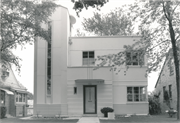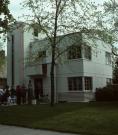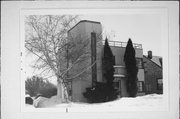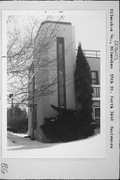Property Record
3840 N 55TH ST
Architecture and History Inventory
| Historic Name: | JOSEPH IELASE HOUSE |
|---|---|
| Other Name: | |
| Contributing: | |
| Reference Number: | 16013 |
| Location (Address): | 3840 N 55TH ST |
|---|---|
| County: | Milwaukee |
| City: | Milwaukee |
| Township/Village: | |
| Unincorporated Community: | |
| Town: | |
| Range: | |
| Direction: | |
| Section: | |
| Quarter Section: | |
| Quarter/Quarter Section: |
| Year Built: | 1932 |
|---|---|
| Additions: | |
| Survey Date: | 1990 |
| Historic Use: | house |
| Architectural Style: | International Style |
| Structural System: | |
| Wall Material: | Metal |
| Architect: | Henry Phillip Plunkett; Home Show Committee |
| Other Buildings On Site: | |
| Demolished?: | No |
| Demolished Date: |
| National/State Register Listing Name: | Not listed |
|---|---|
| National Register Listing Date: | |
| State Register Listing Date: |
| Additional Information: | ADDITIONAL NEGATIVE IS LOCATED IN NEGATIVE FILE 375B/10. PLUNKETT WON A STATE-WIDE DESIGN COMPETITION FOR THIS 1933 HOME SHOW MODEL HOME. IELASE WON THE HOUSE IN A RAFFLE DRAWING AT THE END OF THE SHOW. This structure had the distinction as the 1933 Home Show design winner. Built at a cost of $10,000, it was selected by a committee headed by Alexander C. Eschweiller Jr., supervising architect for the project. Henry Phillip Plunkett of 4417 N. Frederick Ave. submitted the winning design that brought thousands of Milwaukeeans to it's tour. This was the first attemp in Milwaukeeto build in the International Style. Architectual Significance: The new European architecture of the 1920's and 30's was to be known as the International Style. It was a period that offered innovation in design and established a new vocabulary of building constructionthat would be the idiom for subsequent 20th century architecture. Dominated by European architects (ie: France, Germany, Austria) , they represented in their works a reductive cubic geometry which was inspired by the new abstract paintings and early domestic work be Frank Lloyed Wright. In philosophy, the international style works are those of transparency, weightlessness and fragility. Their forms exhibit multi cantilevered planes with glasswalls, hidden supports, and windows that are part of the taught, restrained surface and not just holes in the wall. This structure is a fine example of the period and deserves credit for it's straight-forward use of geometry in deriving its form instead of ornamentation. The total design is somewhat boxy and lacks the horizontal fluidity and openness of the more accomplished works. An important characteristic of this house is the stair towerwhich leads to a roof top terrace. Sheathed in metal panals, the modernity of it's surface is broken by the newspaper 'door' located to the side of the house which could be found of the same design on the 'Cape Code' accross the streetor the English Cottage next door. In it's construction, every possible known building innovation and material were used. The house was one of the first to be totally electric with central air conditioning and wall board instead of plaster was used for the interior finish. "This house was built for the 1933 Home Show sponsored by the Milwaukee Real Estate Board and was the first attempt in Milwaukee to build a house in the International Style. The Home Show conducted a statewide architects' competition and selected this design by Henry Phillip Plunkett of 4417 N. Frederick. Alexander C. Eschweiler, Jr., who chaired the architects' committee and was also the supervising architect on the job, stated "that the committee had in mind treating Milwaukee to a first hand example of modern style which in Europe had become particularly popular. The style is sometimes called "International." The International Style is characterized by minimal detail and precise geometric form. Smooth wall surfaces, flat roofs, cantilevered and projecting floors, and horizontal bands of windows are standard features. The house was built using some unusual methods. In the interior, plasterboard was used instead of plaster and asbestos board was used instead of plaster and asbestos board was used to sheathe the exterior. The windows wrap around the corners of the house and a long narrow pane of glass in the stair tower extends to the second floor and roof. The house was raffled to attendees of the Home Show and was won by Joseph Ielase, who at the time was an unemployed father of three. He took possession of his prize in September 1933 but never actually lived in the house. It was sporadically rented to various tenants until it was sold to Julia and Michael Goldman in 1944. The Goldmans lived there until their deaths in 1976 and 1977. Over the years there was extensive water damage to the house. As a result the present owners have had to tear down most of the original walls and ceilings, so little of the original interior exists. Remaining are two etched glass light fixtures on the landing between the first and second floors. There is also a section of the original metal staircase on the landing leading to the penthouse. The front door is original to the home." Historic Milwaukee Inc., Sherman Park Pride in Craftsmanship 13th Annual Spaces & Traces Tour Saturday, May 14, 1994, Souvenir Booklet. |
|---|---|
| Bibliographic References: | BUILT IN MILWAUKEE, LANDSCAPE RESEARCH, P. 58. Building Permit Milwaukee Journal, 2/12/33 p.4 s.4 " 2/19/33 p.16 s.1 " 3/5/33 p. 4 s. 4 Historic Milwaukee Inc., Sherman Park Pride in Craftsmanship 13th Annual Spaces & Traces Tour Saturday, May 14, 1994, Souvenir Booklet. |
| Wisconsin Architecture and History Inventory, State Historic Preservation Office, Wisconsin Historical Society, Madison, Wisconsin |





